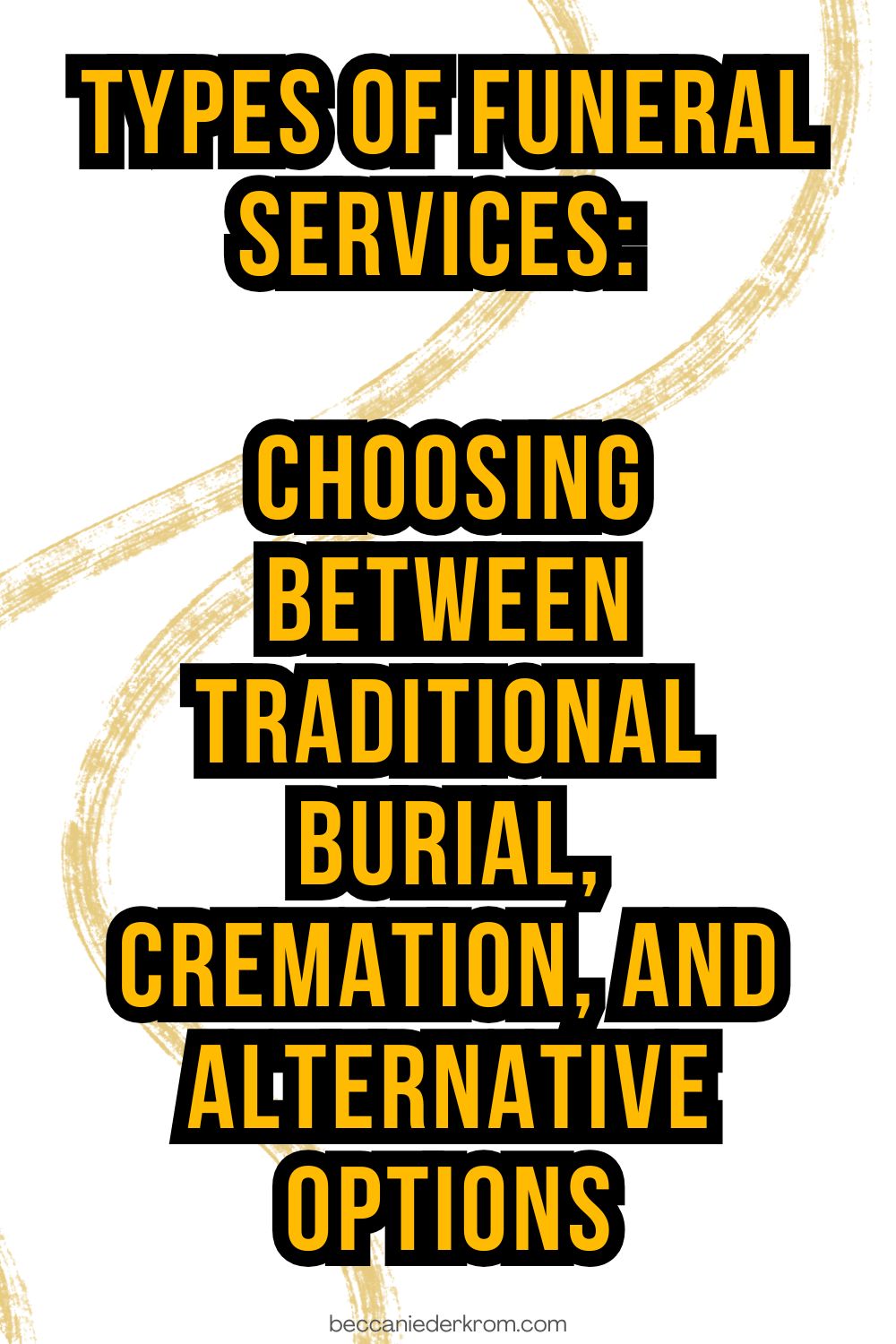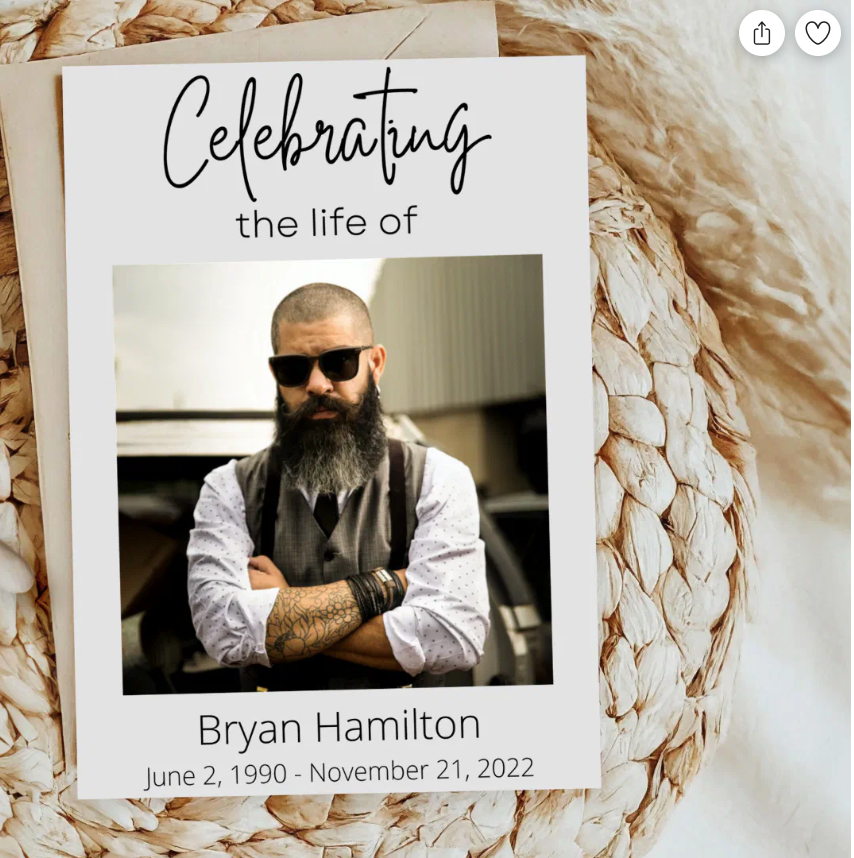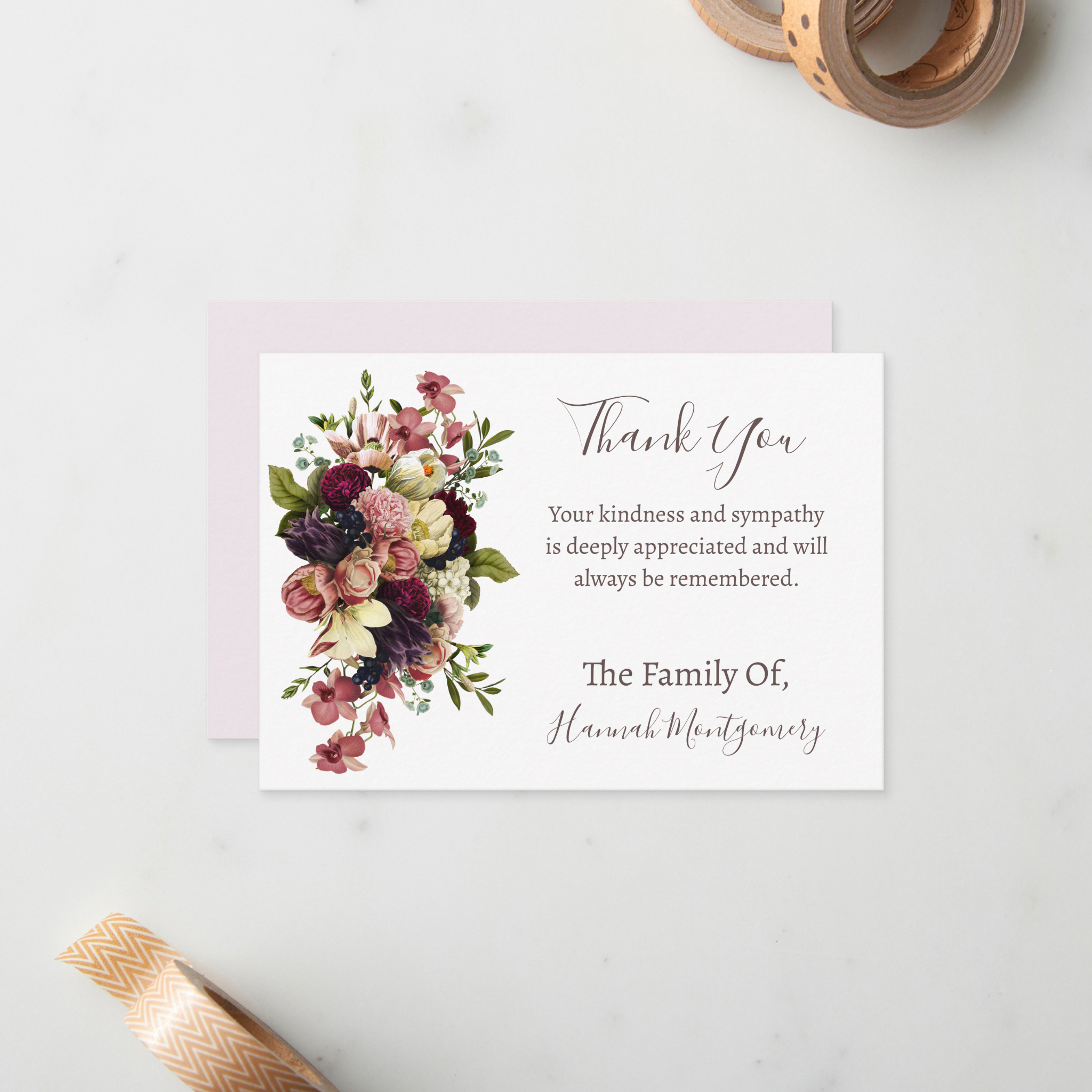We may earn money or products from the companies mentioned in this post. As an Amazon Associate I earn from qualifying purchases. Disclosure of Material Connection: Some of the links in this post may be "affiliate links." This means if you click on the link and purchase an item, I will receive an affiliate commission.
When faced with planning a funeral service, families encounter a range of options that reflect diverse cultural traditions, personal preferences, environmental considerations, and budget constraints. Understanding the various types of funeral services available helps families make informed decisions during a challenging time. This comprehensive guide explores types of funeral services such as traditional burial services, cremation options, and emerging alternatives, providing the information needed to choose the most appropriate memorial for your loved one.
Types of Funeral Services: Choosing Between Traditional Burial, Cremation, and Alternative Options
Understanding the Purpose of Funeral Services
Before exploring specific types of funeral services, it’s important to recognize their fundamental purposes. Funeral services serve several essential functions:
- They provide a structured opportunity to acknowledge the reality of death
- They create space for the expression of grief in a supportive environment
- They allow for the celebration and remembrance of the deceased’s life
- They offer community support for the bereaved
- They facilitate cultural and religious rituals that provide meaning and comfort
- They mark the transition of the deceased from this life to whatever comes next according to one’s beliefs
With these purposes in mind, families can evaluate which type of funeral service best fulfills their needs and honors their loved one’s wishes.
Traditional Burial Services: Time-Honored Practices
Traditional burial services have been the standard in many cultures for generations, particularly in Western societies with Judeo-Christian influences. These services typically follow a familiar structure while allowing for personalization within that framework.
Components of Traditional Burial Services
A complete traditional burial service often includes several distinct components:
Visitation or Viewing
The visitation (sometimes called a viewing or wake) provides an opportunity for friends and family to pay their respects to the deceased and offer condolences to the family. Key aspects include:
- The deceased’s body is present, typically in an open or closed casket
- Embalming is usually performed to preserve the body for viewing
- The event may last several hours or extend over multiple days
- It may be held at a funeral home, place of worship, or family home
- Visitors can come and go throughout the designated hours
Visitations serve an important psychological function, helping mourners acknowledge the reality of death while providing a structured environment for initial grief expression.
SNAG THE FREE FUNERAL PLANNER CHECKLIST HERE
Funeral Ceremony
The funeral ceremony represents the formal service honoring the deceased. Traditional ceremonies often include:
- Religious or spiritual elements reflecting the deceased’s faith
- Eulogies and remembrances from family members and friends
- Music, readings, and prayers selected for their significance
- The presence of the casket, often adorned with flowers
- Formal rituals specific to the deceased’s cultural or religious background
These ceremonies typically last 30-60 minutes and may be held at a place of worship, funeral home chapel, or graveside.
Procession
Following the ceremony, a procession of vehicles travels from the ceremony location to the cemetery. This procession serves as a public acknowledgment of the death and often includes:
- A hearse carrying the casket
- Limousines or cars for immediate family
- Vehicles of extended family and friends, sometimes with funeral flags or headlights on
- Police escort in some communities for larger processions
The procession represents the journey of the deceased to their final resting place and provides a visible community acknowledgment of the passing.
Committal Service
The committal service takes place at the gravesite and marks the final farewell. Elements typically include:
- Brief religious or secular readings
- Final prayers or blessings
- The lowering of the casket or a symbolic lowering
- Opportunity for final goodbyes
- Sometimes, the placing of flowers or soil on the casket
This service finalizes the physical separation and provides closure to the formal funeral proceedings.
Reception
Many traditional funerals conclude with a reception or gathering where attendees share memories, connect with one another, and support the bereaved family. These gatherings often include food and refreshments, photo displays, and informal storytelling about the deceased.
SNAG THE FREE FUNERAL PLANNER CHECKLIST HERE
Advantages of Traditional Burial Services
Traditional burial services offer several benefits that explain their enduring popularity:
- They provide clear structure during a disorienting time of grief
- They align with many religious teachings and cultural expectations
- They offer tangible places for remembrance through grave markers and cemetery visits
- They follow familiar patterns that older generations often find comforting
- They create meaningful ritual experiences that can facilitate healthy grief processing
Considerations for Traditional Burial
While traditional burials remain common, families should consider several factors:
- Cost: Traditional burials typically represent the most expensive funeral option, with national averages ranging from $7,000-$12,000 when including cemetery costs
- Environmental impact: Conventional burials use resources including hardwood or metal caskets, concrete vaults, and embalming chemicals
- Land use: Cemetery space is limited in many areas, leading to higher costs and fewer available locations
- Maintenance: Grave sites require ongoing care, which may involve perpetual care fees or family maintenance responsibilities
Despite these considerations, traditional burial services continue to provide meaningful experiences for many families, particularly those with strong religious or cultural ties to these practices.
Cremation Services: Flexible and Increasingly Popular
Cremation has grown dramatically in popularity over recent decades, with current rates exceeding 50% in the United States and projected to reach nearly 80% by 2040. This shift reflects changing attitudes, religious perspectives, and practical considerations.
Types of Cremation Services
Cremation is not a single type of service but rather a method of final disposition that can be incorporated into various service formats:
Direct Cremation
Direct cremation represents the simplest and most economical option, involving:
- Transportation of the deceased directly to the crematory
- Cremation without a prior viewing or ceremony
- Return of the cremated remains to the family
- No embalming or formal viewing of the body
- Minimal container rather than a traditional casket
This option provides maximum flexibility, as families can hold memorial services at any time and location after receiving the cremated remains.
Cremation with Memorial Service
This increasingly popular option includes:
- Cremation shortly after death
- A memorial service held without the body present
- Often the cremated remains are present in an urn
- Flexible timing, allowing for service planning without the urgency of body preservation concerns
- Opportunity for the same meaningful elements as traditional services
This approach combines the practical benefits of cremation with the emotional and social benefits of a formal gathering.
SNAG THE FREE FUNERAL PLANNER CHECKLIST HERE
Traditional Service Followed by Cremation
Some families prefer to maintain traditional funeral elements while choosing cremation as the final disposition method. This approach includes:
- Embalming and preparation of the body
- Visitation or viewing with the body present
- Formal funeral service with the casket present
- Cremation following these services instead of burial
- Often uses a rental casket or cremation casket
This option preserves familiar rituals while accommodating the preference for cremation.
Disposition Options for Cremated Remains
One of cremation’s primary advantages is the flexibility it offers for final disposition. Options include:
Burial of Cremated Remains
- Interment in a cemetery plot (using less space than traditional burial)
- Placement in a columbarium niche
- Burial on private property where permitted by local regulations
- Interment in a family grave, often with other relatives
Scattering
- Scattering in meaningful locations such as gardens, mountains, or bodies of water
- Scattering gardens specifically designated at cemeteries
- Aerial scattering from aircraft
- Water scattering from boats
- Conservation land scattering through dedicated programs
Keeping the Remains
- Placement in an urn kept at home
- Division among multiple family members in keepsake urns
- Incorporation into memorial jewelry or art pieces
- Transformation into memorial diamonds or glass art
- Storage in biodegradable containers for future scattering or burial
Creative and Emerging Options
- Incorporation into artificial reef structures
- Transformation into vinyl records
- Use in fireworks displays
- Placement in orbiting spacecraft
- Incorporation into tree-planting systems
This flexibility allows families to create highly personalized memorialization plans that reflect the deceased’s personality and preferences.
Advantages of Cremation
Cremation’s growing popularity stems from several advantages:
- Cost efficiency: Typically 40-50% less expensive than traditional burial
- Flexibility: No immediate time pressure for memorial services
- Geographic convenience: Easier management when family members live far apart
- Environmental considerations: Requires fewer resources than traditional burial (though still has environmental impacts)
- Space efficiency: Addresses concerns about cemetery land use
- Portability: Allows for relocation of remains if family moves
- Personalization: Offers diverse options for final disposition
Religious and Cultural Considerations
While cremation was historically prohibited or discouraged in some religious traditions, many faiths have evolved their positions:
- Catholicism: Permitted since 1963, though burial is still preferred
- Protestantism: Generally accepted across most denominations
- Judaism: Traditionally prohibited, though now accepted by Reform and some Conservative communities
- Islam: Generally prohibited in most interpretations
- Hinduism: Traditionally preferred and central to funeral rituals
- Buddhism: Widely accepted and common in Buddhist traditions
Families should consider their religious and cultural backgrounds when evaluating cremation as an option.
Green Burial: Environmentally Conscious Alternatives
As environmental awareness grows, green burial options have emerged as alternatives to both traditional burial and cremation. These approaches emphasize minimal environmental impact and natural decomposition processes.
Principles of Green Burial
Green burial practices typically adhere to several core principles:
- No embalming or use of chemicals that can leach into soil
- Biodegradable caskets, shrouds, or containers
- No concrete vaults or grave liners
- Minimal disruption to the natural landscape
- Conservation and restoration of natural habitats
- Sustainable cemetery management practices
These principles guide various green burial approaches, each offering different levels of environmental commitment.
Types of Green Burial Options
Conservation Burial
The most stringent form of green burial, conservation burial involves:
- Burial within protected natural areas
- Legal conservation status for the land in perpetuity
- Restoration of native plants and ecosystems
- Minimal marking of graves, often using GPS coordinates or natural markers
- Contribution to land conservation efforts through burial fees
Conservation burial grounds like Ramsey Creek Preserve in South Carolina represent both memorial spaces and environmental conservation projects.
Natural Burial Grounds
Natural burial grounds follow green principles while maintaining some conventional cemetery elements:
- Dedicated cemetery space for natural burials
- Prohibition of embalming and non-biodegradable materials
- Allowance for more substantial grave markers, often of natural stone
- Maintained landscapes with emphasis on native plants
- Often sections within conventional cemeteries
These provide a middle ground between conventional and conservation approaches.
Home Burial
In some jurisdictions, burial on private property remains legal, allowing for:
- Burial on family land (subject to zoning regulations and permits)
- Complete control over the burial process
- Minimal transportation and facility costs
- Deep connection to family land and heritage
- Responsibility for maintaining the burial site
This option requires careful research into local regulations and consideration of long-term land ownership.
Shroud and Casket Options
Green burial emphasizes biodegradable containers including:
- Simple wooden caskets without metal hardware
- Woven willow, bamboo, or seagrass caskets
- Recycled cardboard containers
- Natural fiber shrouds
- Biodegradable urns for cremated remains
These options facilitate natural decomposition while minimizing resource use.
Advantages of Green Burial
Green burial appeals to many families because it:
- Aligns with environmental values
- Often costs significantly less than conventional burial
- Provides a more natural aesthetic
- Contributes to land conservation
- Offers a sense of returning to nature
- Creates meaningful ritual through simplicity
- Reduces resource consumption and pollution
Considerations for Green Burial
Families considering green burial should be aware of:
- Limited availability in some geographic areas
- Potential transportation challenges to reach designated green cemeteries
- Varying regulations regarding home burial
- Different aesthetic expectations compared to conventional cemeteries
- Need for advance planning due to fewer available facilities
Emerging Alternative Options
Beyond the three main categories discussed above, several innovative alternatives have emerged in recent years, reflecting changing attitudes toward death care and memorialization.
Alkaline Hydrolysis (Aquamation)
This water-based process represents an alternative to flame cremation:
- Uses water, alkaline chemicals, heat, and pressure to accelerate natural decomposition
- Reduces carbon footprint by about 75% compared to flame cremation
- Produces similar remains to conventional cremation
- Requires about 1/8 the energy of flame cremation
- Legal in a growing number of states and countries
Also known as water cremation, biocremation, or resomation, this option appeals to those seeking reduced environmental impact while maintaining the flexibility of cremation.
Human Composting (Natural Organic Reduction)
Recently legalized in several states, human composting involves:
- Placing the body in a vessel with organic materials
- Controlled decomposition over approximately 30 days
- Transformation into soil that can be used for planting
- Reduction of environmental impact compared to conventional options
- Creation of 1-2 cubic yards of nutrient-rich soil
This emerging option connects death care directly to regenerative natural cycles.
Promession
Still in development and not yet widely available, promession would involve:
- Freezing the body with liquid nitrogen
- Vibration to reduce the body to particles
- Removal of water and metals
- Creation of a powdery substance that quickly decomposes when buried
- Significantly reduced environmental impact
This Swedish innovation represents one of several emerging technologies aimed at providing environmentally conscious alternatives.
Space Burial
For those looking beyond Earth for final disposition:
- Small portions of cremated remains launched into orbit
- Suborbital flights that return to Earth
- Lunar burial options
- Deep space missions
- Memorial spaceflights that create shooting stars
While serving a niche market, these options appeal to those with connections to astronomy, space exploration, or science fiction.
SNAG THE FREE FUNERAL PLANNER CHECKLIST HERE
Making the Decision: Factors to Consider
When choosing between funeral service options, several factors should guide the decision-making process:
Pre-expressed Wishes
The deceased’s previously expressed preferences should receive primary consideration. These might be documented in:
- Advance directives or living wills
- Pre-need funeral arrangements
- Conversations with family members
- Letters or written instructions
- Video or audio recordings
Honoring these wishes provides comfort to family members and respects the deceased’s autonomy.
Religious and Cultural Traditions
For many families, religious and cultural practices provide meaningful frameworks for funeral services:
- Consider the deceased’s level of religious observance and specific denomination
- Consult with religious leaders about appropriate practices
- Balance traditional expectations with personal preferences
- Recognize the comfort that familiar rituals provide during grief
- Acknowledge the importance of community religious practices
These traditions often provide tested approaches to creating meaningful funeral experiences.
Environmental Values
Environmental considerations increasingly influence funeral decisions:
- Evaluate the ecological impact of different options
- Consider the deceased’s environmental values during life
- Research local green funeral providers
- Balance environmental concerns with other important factors
- Recognize that all options have some environmental impact
For those who lived with strong environmental values, funeral choices that reflect these principles provide consistency and meaning.
Budget Realities
Financial considerations necessarily influence funeral planning:
- Be realistic about available resources
- Compare itemized costs across options
- Consider what elements provide the most meaningful experience
- Recognize that expense doesn’t necessarily correlate with quality of experience
- Explore payment options, including insurance, payment plans, and veterans benefits
Open discussion about budget constraints helps families focus resources on the most meaningful aspects of memorialization.
Geographic Considerations
Family dispersion and location affect funeral planning:
- Consider the distance family members must travel
- Evaluate the timing implications for distant relatives
- Explore options for remote participation through technology
- Think about the importance of specific locations to the deceased
- Consider where family members will want to visit for remembrance
These practical considerations help ensure maximum meaningful participation in the funeral experience.
Personalizing Any Funeral Type
Regardless of which type of funeral service you choose, personalization creates meaningful experiences that truly reflect the deceased’s life and personality:
- Incorporate the deceased’s interests, hobbies, and passions
- Select music that held special meaning
- Display photographs and mementos that tell their life story
- Include readings from favorite books or poems
- Create opportunities for attendees to share memories
- Use symbols and objects that represented their values and beliefs
- Consider non-traditional venues that reflect their personality
These personalization elements often create the most memorable and healing aspects of funeral services, regardless of the disposition method chosen.
Conclusion: Finding the Right Path
The diversity of funeral service options available today allows families to create meaningful experiences that honor their loved ones in ways that align with personal values, cultural traditions, and practical considerations. Whether choosing traditional burial with its structured rituals, cremation with its flexibility, green burial with its environmental focus, or emerging alternatives with their innovative approaches, the most important factor is creating an authentic tribute that facilitates healthy grief expression and honors the unique life that was lived.
By understanding the full spectrum of options and carefully considering the factors most important to your situation, you can navigate this difficult decision with confidence. Remember that funeral service professionals can provide valuable guidance based on their experience, while ultimately respecting that the best choices are those that most meaningfully reflect the deceased’s life and provide comfort to those mourning their loss.
Whatever option you choose, the act of coming together to acknowledge a death, celebrate a life, and support one another in grief remains the essential purpose of funeral services across all their diverse forms.





